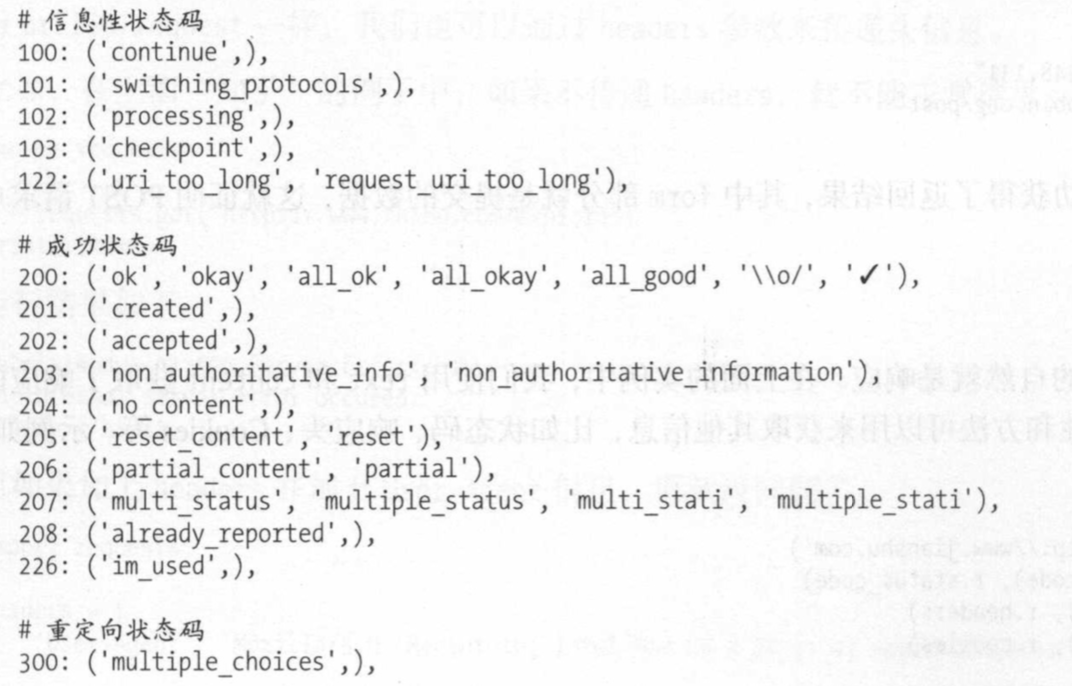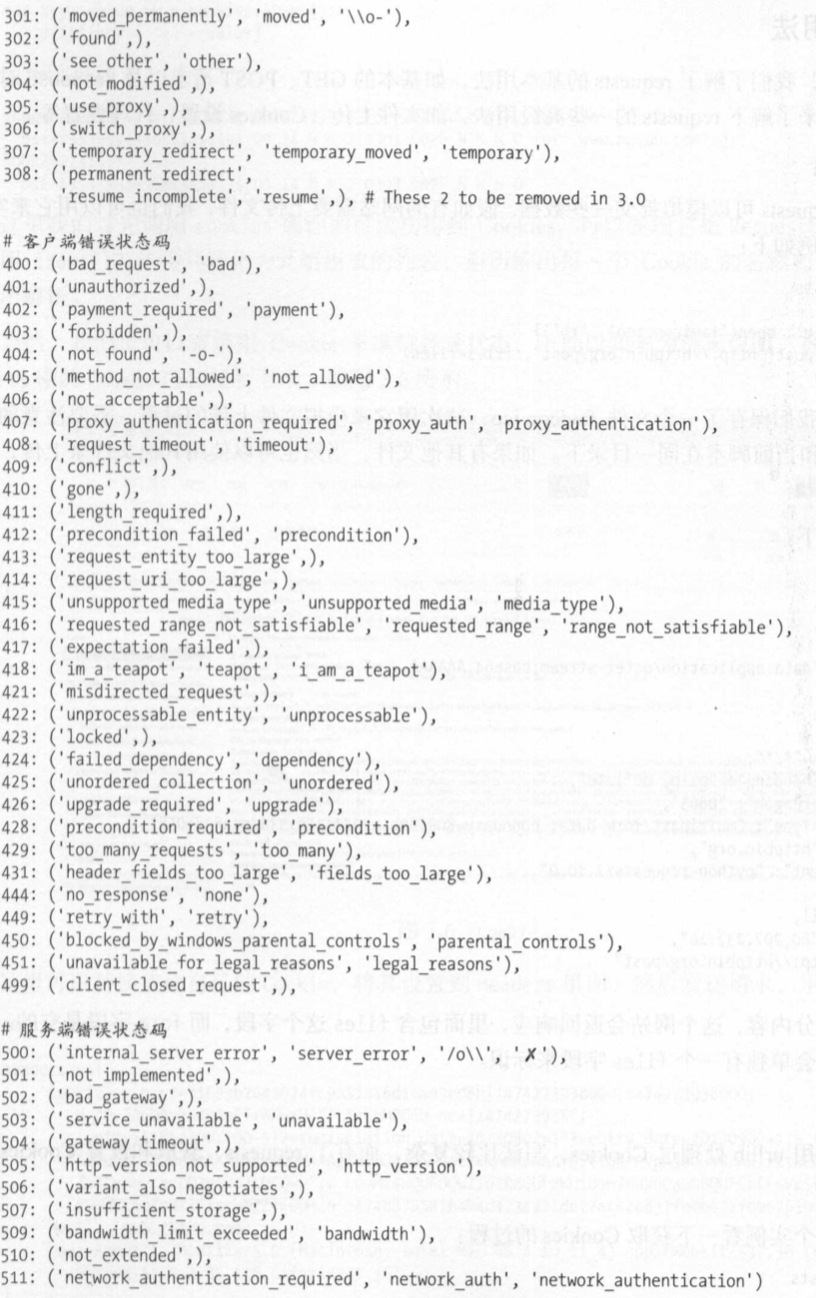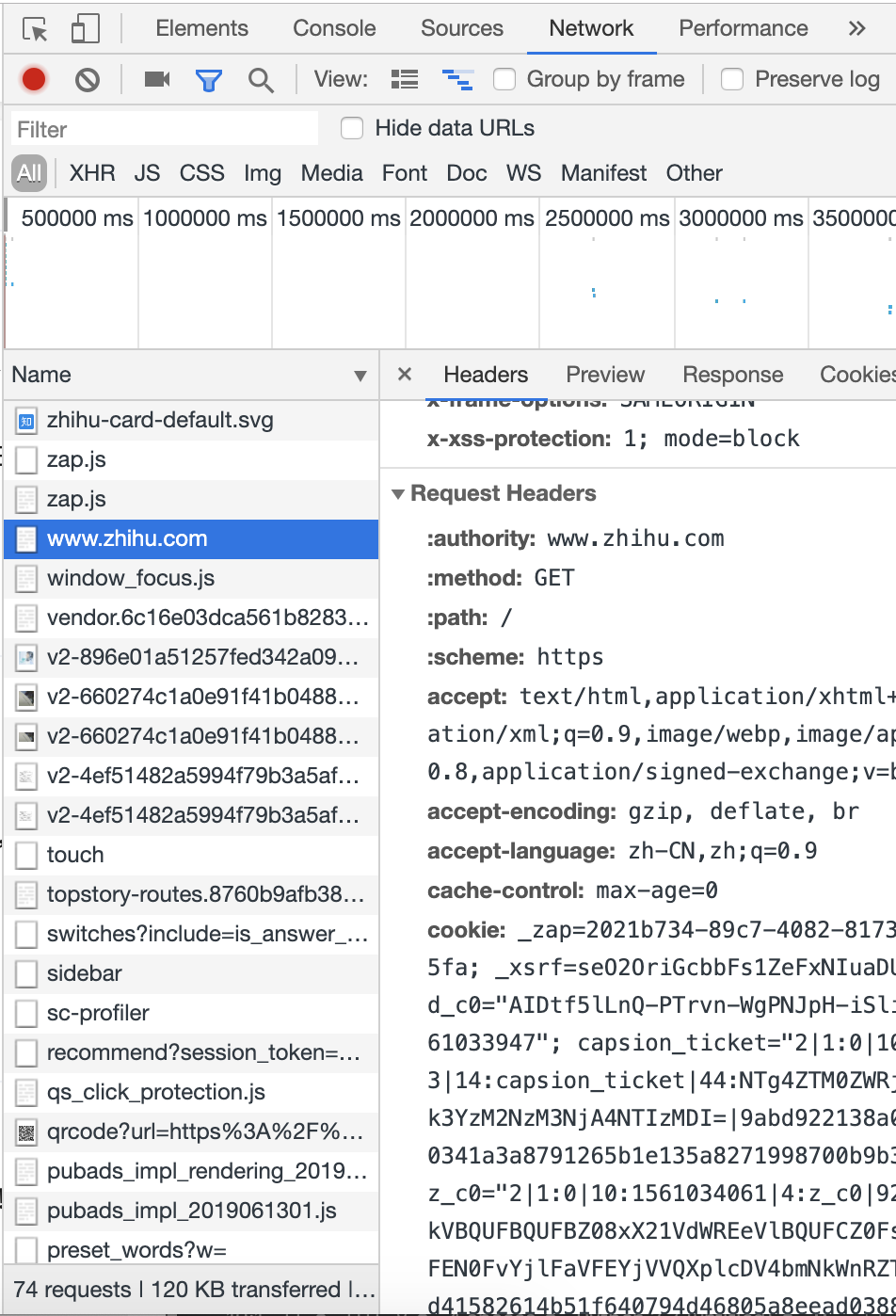爬虫基本库的使用---requests库
使用requests---实现Cookies、登录验证、代理设置等操作
处理网页验证和Cookies时,需要写Opener和Handler来处理,为了更方便地实现这些操作,就有了更强大的库requests
例子简单使用requests库
import requests r = requests.get('http://wwww.baidu.com/')
print(type(r), r.status_code, r.text, r.cookies, sep='\n\n') # 输出:
<class 'requests.models.Response'> 200 <!DOCTYPE html>
<!--STATUS OK--><html> <head><meta http-equiv=content-type content=text/html;charset=utf-8><meta http-equiv=X-UA-Compatible
......
feedback>æè§åé¦</a> 京ICPè¯030173å· <img src=//www.baidu.com/img/gs.gif> </p> </div> </div> </div> </body> </html> <RequestsCookieJar[<Cookie BDORZ=27315 for .baidu.com/>]>GET请求
- GET请求,返回相应的请求信息
- requests.get(url, params, **kwargs)
- url表示要捕获的页面链接,params表示url的额外参数(字典或字节流格式),**kwargs表示12个控制访问的参数
import requests r = requests.get('http://httpbin.org/get')
print(r.text) # 输出:
{
"args": {},
"headers": {
"Accept": "*/*",
"Accept-Encoding": "gzip, deflate",
"Host": "httpbin.org",
"User-Agent": "python-requests/2.21.0"
},
"origin": "120.85.108.192, 120.85.108.192",
"url": "https://httpbin.org/get"
} # 返回结果中包含请求头、URL、IP等信息import requests data = {
'name': 'LiYihua',
'age': ''
}
r = requests.get('http://httpbin.org/get', params=data)
print(r.text) # 输出:
{
"args": {
"age": "",
"name": "LiYihua"
},
"headers": {
"Accept": "*/*",
"Accept-Encoding": "gzip, deflate",
"Host": "httpbin.org",
"User-Agent": "python-requests/2.21.0"
},
"origin": "120.85.108.92, 120.85.108.92",
"url": "https://httpbin.org/get?name=LiYihua&age=21"
}import requests r = requests.get('http://httpbin.org/get')
print(type(r.text), r.json(), type(r.json()), sep='\n\n') # 输出:
<class 'str'> {'args': {}, 'headers': {'Accept': '*/*', 'Accept-Encoding': 'gzip, deflate', 'Host': 'httpbin.org', 'User-Agent': 'python-requests/2.21.0'}, 'origin': '120.85.108.92, 120.85.108.92', 'url': 'https://httpbin.org/get'} <class 'dict'> # json()方法可以将返回结果是JSON格式的字符串转化为字典抓取二进制数据
import requests r = requests.get('https://github.com/favicon.ico')
print(r.text, r.content, sep='\n\n') # response.content返回的是bytes型的数据。
# 如果想取图片,文件,则可以通过r.content # response.text返回的是Unicode型的数据。
# 如果想取文本,可以通过r.text # 输出:
:�������OL��...... b'\x00\x00\x01\x00\x02\x00\x10\x10\x00\x00\x0......将提取到的图片保存
import requests r = requests.get('https://github.com/favicon.ico')
with open('favicon.ico', 'wb') as f:
f.write(r.content) # 运行结束后生成一个名为favicon.ico的图标上一个例子用到的open()方法和with as语句
# open()方法
# def open(file, mode='r', buffering=None, encoding=None, errors=None, newline=None, closefd=True) # 常用参数:
file表示要打开的文件 mode表示打开文件的模式:只读,写入,追加等 buffering : 如果 buffering 的值被设为 0,就不会有寄存。如果 buffering 的值取 1,访问文件时会寄存行。如果将 buffering 的值设为大于 1 的整数,表明了这就是的寄存区的缓冲大小。如果取负值,寄存区的缓冲大小则为系统默认 # 对于mode参数
========= ===============================================================
字母的意义
--------- ---------------------------------------------------------------
'r' 打开阅读(默认)
'w' 打开进行写入,首先截断文件
'x' 创建一个新文件并打开它进行写入
'a' 打开进行写入,如果文件存在,则附加到文件结尾
'b' 二进制模式
't' 文本模式(默认)
'+' 打开磁盘文件进行更新(读写)
'U' 通用换行模式(已弃用)
========= =============================================================== # with as 语句
有一些任务,可能事先需要设置,事后做清理工作。对于这种场景,Python的with语句提供了一种非常方便的处理方式。
with的处理基本思想是with所求值的对象必须有一个__enter__()方法,一个__exit__()方法。紧跟with后面的语句被求值后,返回对象的__enter__()方法被调用,这个方法的返回值将被赋值给as后面的变量。当with后面的代码块全部被执行完之后,将调用前面返回对象的__exit__()方法。
代码解释说明:
class Sample:
def __enter__(self):
print "In __enter__()"
return "Foo" def __exit__(self, type, value, trace):
print "In __exit__()" def get_sample():
return Sample() with get_sample() as sample:
print "sample:", sample添加headers
import requests r = requests.get('https://www.zhihu.com/explore')
print(r.text) # 输出:
<html>
<head><title>400 Bad Request</title></head>
<body bgcolor="white">
<center><h1>400 Bad Request</h1></center>
<hr><center>openresty</center>
</body>
</html> # 部分网址需要传递headers,如果不传递,就不能正常请求
import requests headers = {
'User-Agent': 'Mozilla/5.0 (Macintosh; Intel Mac OS X 10_14_5) AppleWebKit/537.36 (KHTML, like Gecko '
'Chrome/52.0.2743.116 Safari/537.36'
}
r = requests.get('https://www.zhihu.com/explore', headers=headers)
print(r.text) # 输出:
<!DOCTYPE html>
<html lang="zh-CN" dropEffect="none" class="no-js no-auth ">
<head>
<meta charset="utf-8" />
......
<script type="text/zscript" znonce="d78db0c15fa84270ac967503884baf11"></script> <input type="hidden" name="_xsrf" value="cdb6166e0dc5f38afc3ee95053d7ef55"/>
</body>
</html>
- url表示要捕获的页面链接,params表示url的额外参数(字典或字节流格式),**kwargs表示12个控制访问的参数
POST请求
- 这是一种比较常见的URL请求方式
import requests data = {
'name': 'LiYihua',
'age': 21
}
r = requests.post('http://httpbin.org/post', data=data)
print(r.text) # 输出:
{
"args": {},
"data": "",
"files": {},
"form": {
"age": "",
"name": "LiYihua"
},
"headers": {
"Accept": "*/*",
"Accept-Encoding": "gzip, deflate",
"Content-Length": "",
"Content-Type": "application/x-www-form-urlencoded",
"Host": "httpbin.org",
"User-Agent": "python-requests/2.21.0"
},
"json": null,
"origin": "120.85.108.90, 120.85.108.90",
"url": "https://httpbin.org/post"
} # POST请求成功,获得返回结果,form部分为提交的数据
- 这是一种比较常见的URL请求方式
响应
text 和 content 获取响应的内容
status code 属性得到状态码 headers 属性得到响应头 cookies属性得到 Cookies
url属性得到 URL history属性得到请求历史
import requests r = requests.get('https://www.cnblogs.com/liyihua/') print(type(r.status_code), r.status_code,
type(r.headers), r.headers,
type(r.cookies), r.cookies,
type(r.url), r.url,
type(r.history), r.history,
sep='\n\n') # 输出:
<class 'int'> 200 <class 'requests.structures.CaseInsensitiveDict'> {'Date': 'Thu, 20 Jun 2019 08:18:00 GMT', 'Content-Type': 'text/html; charset=utf-8', 'Transfer-Encoding': 'chunked', 'Connection': 'keep-alive', 'Vary': 'Accept-Encoding', 'Cache-Control': 'private, max-age=10', 'Expires': 'Thu, 20 Jun 2019 08:18:10 GMT', 'Last-Modified': 'Thu, 20 Jun 2019 08:18:00 GMT', 'X-UA-Compatible': 'IE=10', 'X-Frame-Options': 'SAMEORIGIN', 'Content-Encoding': 'gzip'} <class 'requests.cookies.RequestsCookieJar'> <RequestsCookieJar[]> <class 'str'> https://www.cnblogs.com/liyihua/ <class 'list'> []状态码通常用来判断请求是否成功
import requests r = requests.get('http://www.baidu.com')
exit() if not r.status_code == requests.codes.ok else print('Request Successfully') # 输出:
Request Successfully # request.codes.ok 返回成功的状态码200返回码和相应的查询条件


高级用法
文件上传
import requests files = {
'file': open('favicon.ico', 'rb')
}
r = requests.post('http://httpbin.org/post', files=files)
print(r.text) # 输出:
{
"args": {},
"data": "",
"files": {
"file": "data:application/octetstream;base64,AAABAAIAEBAAAAEAIAAoBQAAJgAAACAgAAABACAAKBQAAE4FAAAoAAAAEAAAACAAAAABACAAAAAAAAAFAAA...
},
"form": {},
"headers": {
"Accept": "*/*",
"Accept-Encoding": "gzip, deflate",
"Content-Length": "",
"Content-Type": "multipart/form-data; boundary=c1b665273fc73e67e57ac97e78f49110",
"Host": "httpbin.org",
"User-Agent": "python-requests/2.21.0"
},
"json": null,
"origin": "120.85.108.71, 120.85.108.71",
"url": "https://httpbin.org/post"
}Cookies
import requests headers = {
'Cookie': 'tgw_l7_route=66cb16bc7......ECLNu3tQ',
'Host': 'www.zhihu.com',
'User-Agent': 'Mozilla/5.0 (Macintosh; Intel Mac OS X 10_11_4) AppleWebKit/537.36 (KHTML, like Gecko) Chrome/53.0.2785.116 Safari/537.36'
}
r = requests.get('https://www.zhihu.com', headers=headers)
print(r.text) # 输出:
<!doctype html>
<html lang="zh" data-hairline="true" data-theme="light"><head><meta charSet="utf-8"/><title data-react-helmet="true">首页 - 知乎</title><meta name="viewport" ......
# 说明登录成功 # Cookie维持登录状态,首先登录知乎,复制headers中的Cookie,然后将其设置到Headers里面,然后发送请求from requests.cookies import RequestsCookieJar
import requests cookies = 'tgw_l7_route=66cb16bc7f45da64562a07.......ALNI_MbNds66nlodoTCxp8EVE6ECLNu3tQ'
jar = requests.cookies.RequestsCookieJar() headers = {
'Host': 'www.zhihu.com',
'User-Agent': 'Mozilla/5.0 (Macintosh; Intel Mac OS X 10_11_4) AppleWebKit/537.36 (KHTML, like Gecko) Chrome/53.0.2785.116 Safari/537.36'
} for cookies in cookies.split(';'):
key, value = cookies.split('=', 1)
jar.set(key, value) r = requests.get('https://www.zhihu.com', cookies=jar, headers=headers)
print(r.text) # 输出同上面一样
# 将复制下来的cookies利用split()方法处理分割
# 创建RequestsCookieJar对象,利用set()方法设置好每个Cookie的key和value
会话维持
Session对象,可以方便的维护一个会话
import requests requests.get('http://httpbin.org/cookies/set/number/123456789')
r = requests.get('http://httpbin.org/cookies')
print(r.text) # 输出:
{
"cookies": {}
} import requests s = requests.Session()
s.get('http://httpbin.org/cookies/set/number/123456789')
r = s.get('http://httpbin.org/cookies')
print(r.text) # 输出:
{
"cookies": {
"number": ""
}
}SSL证书验证
import requests r = requests.get('https://www.12306.cn')
print(r.status_code) # 没有出错会输出:200
# 如果请求一个HTTPS站点,但是证书验证错误的页面时,就会错误。 # 为了避免错误,可以将改例子稍作修改
import requests
from requests.packages import urllib3 urllib3.disable_warnings()
r = requests.get('https://www.12306.cn', verify=False)
print(r.status_code)代理设置
import requests proxies = {
'http': 'socks5://user:password@10.10.1.10:3128',
'https': 'socks5://user:password@10.10.1.10:1080'
} requests.get('https://www.taobao.com', proxies=proxies) # 使用SOCKS协议代理超时设置
import requests r = requests.get('https://taobao.com', timeout=(0.1, 1))
print(r.status_code) # 输出:200- 身份验证
import requests
from requests.auth import HTTPBasicAuth r = requests.get('http://localhost', auth=HTTPBasicAuth('liyihua', 'woshiyihua134'))
print(r.status_code) # 输出:200 # 也可以使用OAuth1方法
import requests
from requests_oauthlib import OAuth1 url = 'https://api.twitter.com/1.1/account/verify_credentials.json'
auth = OAuth1('YOUR_APP_KEY', 'YOUR_APP_SECRET'
'USER_OAUTH_TOKEN', 'USER_OAUTH_TOKEN_SECRET')
requests.get(url, auth=auth) Prepared Request(准备请求)
要获取一个带有状态的 Prepared Request, 需要用Session.prepare_request()
from requests import Request, Session url = 'http://httpbin.org/post'
data = {
'name': 'LiYihua'
} # 参数
header = {
'User-Agent': 'Mozilla/5.0 (Macintosh; Intel Mac OS X 10_11_4) AppleWebKit/537 (KHTML, like Gecko Chrome/53.0.2785.116 Safari/537.36'
} # 伪装浏览器
s = Session() # 会话维持
req = Request('POST', url, data=data, headers=header) prepped = s.prepare_request(req) # Session的prepare_request()方法将req转化为一个 Prepared Request对象
r = s.send(prepped) # send() 发送请求
print(r.text) # 输出:
{
"args": {},
"data": "",
"files": {},
"form": {
"name": "LiYihua"
},
"headers": {
"Accept": "*/*",
"Accept-Encoding": "gzip, deflate",
"Content-Length": "",
"Content-Type": "application/x-www-form-urlencoded",
"Host": "httpbin.org",
"User-Agent": "Mozilla/5.0 (Macintosh; Intel Mac OS X 10_11_4) AppleWebKit/537 (KHTML, like Gecko Chrome/53.0.2785.116 Safari/537.36"
},
"json": null,
"origin": "120.85.108.184, 120.85.108.184",
"url": "https://httpbin.org/post"
}
爬虫基本库的使用---requests库的更多相关文章
- 爬虫1.1-基础知识+requests库
目录 爬虫-基础知识+requests库 1. 状态返回码 2. URL各个字段解释 2. requests库 3. requests库爬虫的基本流程 爬虫-基础知识+requests库 关于html ...
- Python爬虫:HTTP协议、Requests库(爬虫学习第一天)
HTTP协议: HTTP(Hypertext Transfer Protocol):即超文本传输协议.URL是通过HTTP协议存取资源的Internet路径,一个URL对应一个数据资源. HTTP协议 ...
- Python爬虫(二):Requests库
所谓爬虫就是模拟客户端发送网络请求,获取网络响应,并按照一定的规则解析获取的数据并保存的程序.要说 Python 的爬虫必然绕不过 Requests 库. 1 简介 对于 Requests 库,官方文 ...
- 爬虫(三):Requests库的基本使用
一:什么是Requests Requests是用python语言基于urllib编写的,采用的是Apache2 Licensed开源协议的HTTP库如果你看过上篇文章关于urllib库的使用,你会发现 ...
- Python爬虫学习==>第八章:Requests库详解
学习目的: request库比urllib库使用更加简洁,且更方便. 正式步骤 Step1:什么是requests requests是用Python语言编写,基于urllib,采用Apache2 Li ...
- python之爬虫(四)之 Requests库的基本使用
什么是Requests Requests是用python语言基于urllib编写的,采用的是Apache2 Licensed开源协议的HTTP库如果你看过上篇文章关于urllib库的使用,你会发现,其 ...
- Python爬虫:HTTP协议、Requests库
HTTP协议: HTTP(Hypertext Transfer Protocol):即超文本传输协议.URL是通过HTTP协议存取资源的Internet路径,一个URL对应一个数据资源. HTTP协议 ...
- 爬虫入门【2】Requests库简介
发送请求 使用Requests发送网络请求很简单 #首先要导入requests库 import requests #返回一个Response对象 r=requests.get('https://git ...
- python爬虫---从零开始(三)Requests库
1,什么是Requests库 Requests是用python语言编写,基于urllib,采用Apache2 Licensed 开源协议的HTTP库. 它比urllib更加方便,可以节约我们大量的工作 ...
随机推荐
- 数据库系统概论——SQL
[toc] 一.SQL查询语言概览 视图 从一个或几个基本表导出的表 数据库中只存放视图的定义而不存放视图对应的数据 视图是一个虚表 用户可以在视图上再定义视图 基本表 本身独立存在的表 SQL中一个 ...
- bootstrap具体知识点(2)
3.以移动设备为优先 <meta name=”viewport” content=”width=device-width,initial-scale=1,user-scalable=no”> ...
- Kafka 学习笔记之 架构
Kafka的概念: 1. AMQP协议 Advanced Message Queuing Protocol (高级消息队列协议) The Advanced Message Queuing Protoc ...
- HTML5存储--离线存储
离线存储技术 HTML5提出了两大离线存储技术:localstorage与Application Cache,两者各有应用场景:传统还有离线存储技术为Cookie. 经过实践我们认为localstor ...
- Mac 10.14在新窗口中打开文件夹
Mac 10.14 Open folders in new window (high Sierra) System Preferences > Dock. Change "Prefer ...
- Java中获取刚插入数据库中的数据Id(主键,自动增长)
public int insert(String cName, String ebrand, String cGender) { String sql = "insert into Clot ...
- 域渗透-凭据传递攻击(pass the hash)完全总结
总结下PtH具体形式(wmicexec.powershell.msf等) 0x01 PtH攻击原理 && 黄金白银票据 PtH攻击原理 wiki https://en.wikiped ...
- phpstorm 设置换行符的格式
菜单 > 文件 > 设置
- Dubbo+Zookeeper(一)Zookeeper初识
前面花了一段时间去学习SpringCloud的相关知识,主要是理解微服务的概念并使用SpringCloud的一系列组件实现微服务落地.学习这些组件本身是简单的,跟着操作一遍基本就会了,这也得益于Spr ...
- Flink 从 0 到 1 学习 —— 如何自定义 Data Source ?
前言 在 <从0到1学习Flink>-- Data Source 介绍 文章中,我给大家介绍了 Flink Data Source 以及简短的介绍了一下自定义 Data Source,这篇 ...
